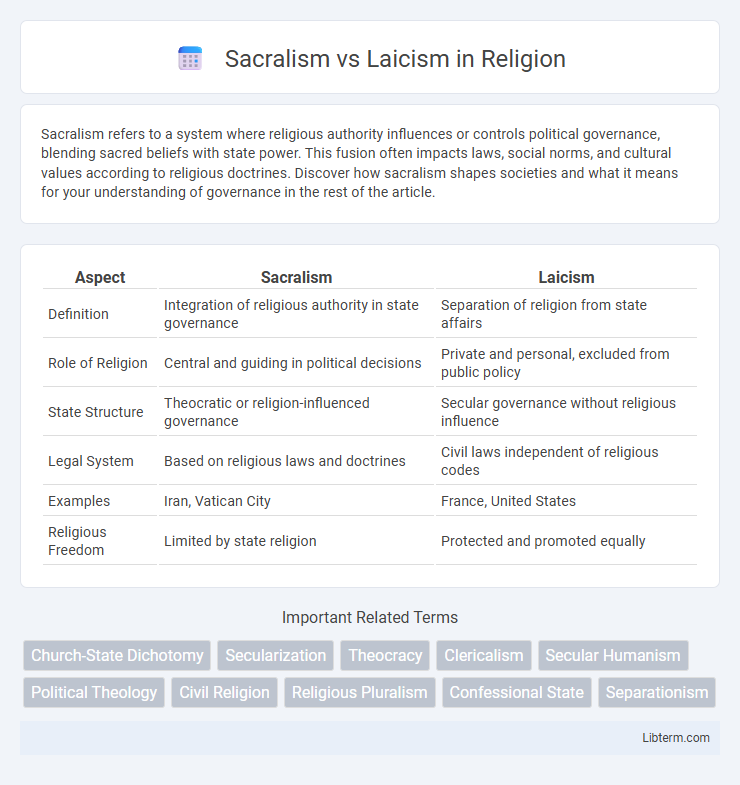Sacralism refers to a system where religious authority influences or controls political governance, blending sacred beliefs with state power. This fusion often impacts laws, social norms, and cultural values according to religious doctrines. Discover how sacralism shapes societies and what it means for your understanding of governance in the rest of the article.
Table of Comparison
| Aspect | Sacralism | Laicism |
|---|---|---|
| Definition | Integration of religious authority in state governance | Separation of religion from state affairs |
| Role of Religion | Central and guiding in political decisions | Private and personal, excluded from public policy |
| State Structure | Theocratic or religion-influenced governance | Secular governance without religious influence |
| Legal System | Based on religious laws and doctrines | Civil laws independent of religious codes |
| Examples | Iran, Vatican City | France, United States |
| Religious Freedom | Limited by state religion | Protected and promoted equally |
Understanding Sacralism: Definition and Origins
Sacralism refers to the integration of religious authority with political governance, where religious institutions hold significant influence over state affairs. Originating in ancient civilizations and deeply rooted in theocratic traditions, sacralism often manifests in legal systems and cultural norms aligned closely with religious doctrines. This concept contrasts sharply with laicism, which advocates for a strict separation between religion and state to ensure secular governance.
Laicism Explained: Principles and Historical Context
Laicism, rooted in the principle of separating religion from governmental institutions, ensures state neutrality in religious matters by promoting secular governance and protecting freedom of conscience. Historically, laicism emerged prominently during the Enlightenment era and gained institutional strength in countries like France with the 1905 Law on the Separation of Churches and State. This framework fosters pluralism and prevents religious influence in public policy, education, and civil affairs, thereby safeguarding democratic values and individual rights.
Key Differences Between Sacralism and Laicism
Sacralism emphasizes the integration of religion and state, where religious authority directly influences political governance and legal systems. Laicism advocates for the strict separation of religion from state affairs, ensuring secular governance without religious intervention in political processes. The key differences lie in the role religion plays in public policy, with sacralism merging religious dogma and law, while laicism promotes neutrality and freedom from religious control in governmental institutions.
Historical Evolution of State-Religion Relations
Sacralism, rooted in theocratic principles, historically intertwined religious authority with state governance, exemplified by medieval Europe's divine right of kings and the Catholic Church's influence over monarchies. Laicism emerged notably in 19th-century France during the Enlightenment and the subsequent Third Republic, establishing a strict separation between religious institutions and the state to promote secular governance and religious neutrality. This evolution reflects broader shifts from religious legitimization of political power toward modern secularism prioritizing individual freedoms and pluralism in diverse societies.
Impact of Sacralism on Society and Governance
Sacralism profoundly influences society and governance by intertwining religious authority with political power, often leading to laws and policies rooted in religious doctrines. This fusion can affect civil liberties, where religious norms shape educational systems, judicial rulings, and public morality standards, potentially marginalizing secular voices. Societies governed by sacralist principles may experience reduced pluralism and increased challenges to democratic governance due to the dominance of religious institutions in political decision-making.
The Role of Laicism in Modern Democracies
Laicism defines the separation of religion from governmental institutions, ensuring state neutrality and protecting citizens' freedom of belief. Modern democracies implement laicism to prevent religious influence on public policy, promote equality among diverse populations, and uphold secular education systems. This framework enhances social cohesion by maintaining impartiality in lawmaking and public administration, thereby fostering inclusive political environments.
Case Studies: Countries Practicing Sacralism
Countries practicing sacralism, such as Iran, Saudi Arabia, and Vatican City, integrate religious authority directly into their political systems, shaping legislation and governance based on religious doctrines. Iran's Islamic Republic combines clerical leadership with state institutions, resulting in a theocratic model where Sharia law influences policy and civil rights. Saudi Arabia enforces Wahhabi interpretation of Islam within its legal framework, while Vatican City operates as a sovereign ecclesiastical state led by the Pope, exemplifying sacralism through centralized religious governance.
Case Studies: Countries Embracing Laicism
France exemplifies laicism by firmly separating church and state, ensuring religious neutrality in public institutions and promoting secular education under the 1905 Law on the Separation of Churches and State. Turkey's laicism is institutionalized through strict secular policies enforced by the state, maintaining government control over religious affairs to minimize religious influence in politics. India balances laicism with secularism by protecting religious freedom and promoting equal treatment of all religions, despite facing challenges related to religious diversity and communal tensions.
Challenges and Controversies in State-Religion Separation
Sacralism challenges state neutrality by promoting religious authority within government, often leading to the suppression of minority beliefs and limiting secular freedoms. Laicism faces controversies around its enforcement, as strict separation may marginalize religious expressions in public life, provoking debates on cultural identity and freedom of conscience. Both approaches struggle with balancing the rights of religious groups and the secular state, causing ongoing legal and social tensions worldwide.
Future Trends: Balancing Faith and Secular Governance
Sacralism, advocating for governance influenced by religious principles, faces increasing challenges in diverse, pluralistic societies where laicism promotes separation of church and state to ensure impartial public policies. Future trends indicate a growing emphasis on hybrid models that seek equilibrium between respecting religious traditions and upholding secular legal frameworks. Emerging global dynamics highlight the need for inclusive governance structures that balance faith-driven moral values with universal human rights and democratic principles.
Sacralism Infographic

 libterm.com
libterm.com